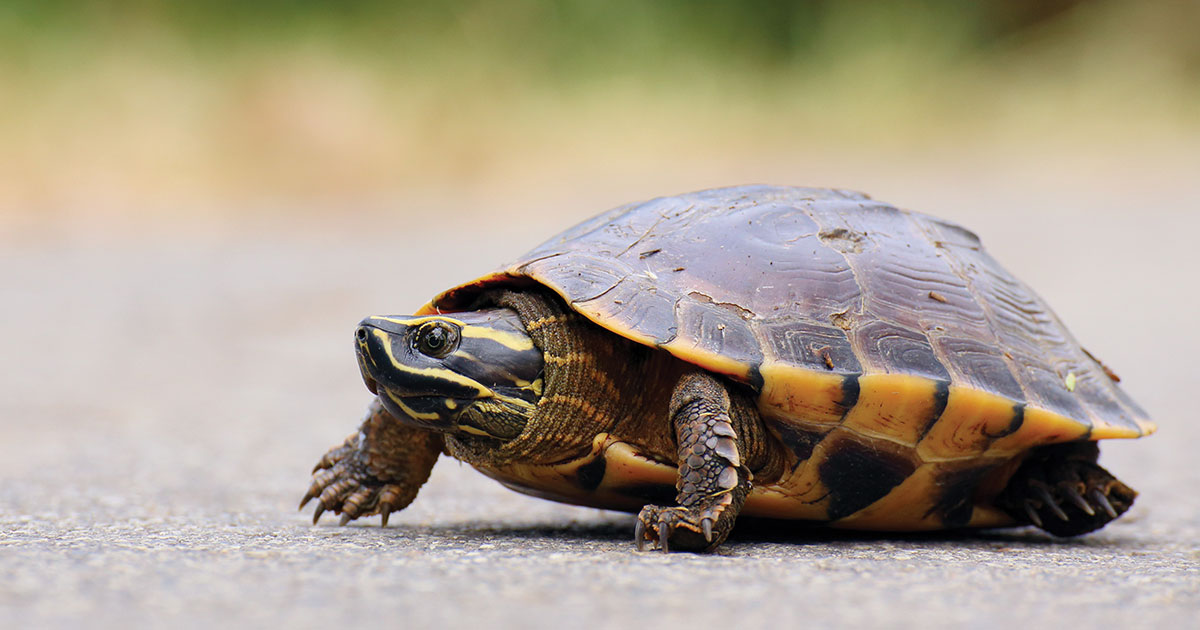It’s the season of clawed feet and a rounded shell slowly making its way across the road. Turtles. Yes, box turtles, red or yellow-bellied slider turtles, and snapping turtles make their appearance from spring through fall. Similar to your path behind the wheel destined to reach one destination before returning home, the turtle moves in the same pattern. Based on the resources it is likely to find, the turtle can travel a distance and find its way home.
Types of Turtles
The box turtle is a terrestrial animal, which means land-dwelling, in areas such as wetland edges, damp forests or grassy fields. Not adept at swimming as aquatic turtles, they do enjoy sitting in shallow stream beds. Baby box turtles may be cute due to their small size; however, as independent creatures, they can locate food and shelter by themselves. The domed shell has a specialized feature, a hinge to help the turtle escape predators. Although they can survive for 100 years, the box turtle populations are close to becoming on the endangered species list.
The slider turtles are land and aquatic animals, most notable for their colorful striped markings, usually red or yellow. Similar in size, yellow and red-bellied sliders are typically five to nine inches in length, but the female is much larger, spanning eight to 13-inches. Sliders have a considerable lifespan, living over 30 years in the wild.
The snapping turtle is a fearsome creature and is not safe to approach due to the ease in which it can flex its head muscles and extend to bite. (Even the baby, recognizable by its long neck, has sharp teeth.) Adults are large in body with a rocky shell and weigh, on average, between nine and 35 pounds. In the wild, enjoying freshwater lakes, streams, and ponds, it can live 30 years.
The Location of the Turtle
While the turtle may be slowly journeying through terrifying environments such as crossing a road or parking lot, it has a distinct purpose. Egg-laden females seek an appropriate nesting site, while males may be on a journey home. Picking up and carrying it to another destination will subject the turtle to perhaps a foreign disease or parasites. Turtles have one objective: to finish its mission.
As a turtle helper, or trekker, you can provide several well-needed and kind services:
- Locating a Turtle: It’s a thrill to find a reptile! The first thought upon coming across a healthy turtle is to look ahead to a grassy location. In the direction it is facing, palm the width of the shell with one hand, and carry it slowly and low to the ground. Never turn a reptile upside down, or place your hand underneath. Some turtles have sharp claws.
- Protect a Turtle from Danger: Reptiles are often difficult to see. It’s wise to be aware of turtles during unexpected activities such as driving, mowing the lawn, and walking dogs. Free-roaming dogs and cats are responsible for killing wild animals each year; therefore, be proactive and keep your domestic animal either indoors or on a lead.
- Checking Health: Not all turtles are in perfect health; sometimes, a turtle may appear sick, showing signs of a discharge emanating from its ears or nose, have an injured foot, or a slightly cracked shell. Only water turtles, namely box turtles, can regenerate and reform granular tissues; although the process is slow and may result in infection and death. While the Piedmont Wildlife Center, PWC, has a Turtle Team to aid in injured reptiles, a closer resource is the Kernersville Reptile Zoo and Medical Center.
Tip: Check out the YouTube channel, Reptile Rangers, to watch local professionals safely aid in rescuing and removing various reptiles.
Help in Saving the Eastern Box Turtles
Since 2009, North Carolina’s Piedmont Wildlife Center seeks citizen scientists to aid in finding information about the Eastern box turtle’s movements. By knowing the location of box turtles, you can assist the cause of saving a dying species. Whether you are an adult or child, together, we can unite and assist a reptile population. Check out the PWC’s website, and join the Neighborhood Turtle Watch!



















